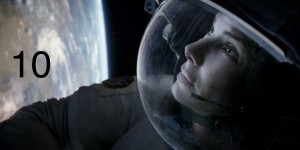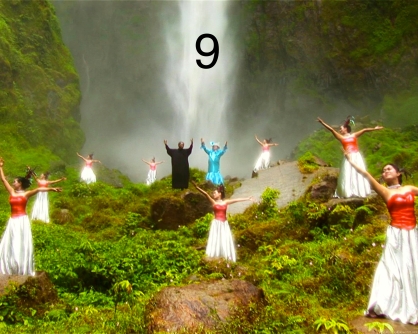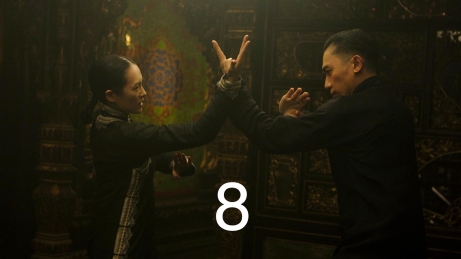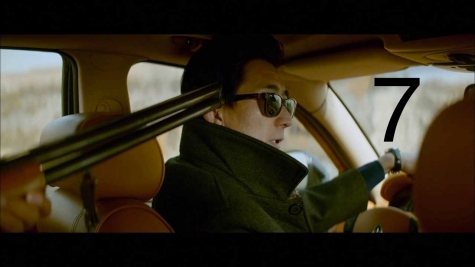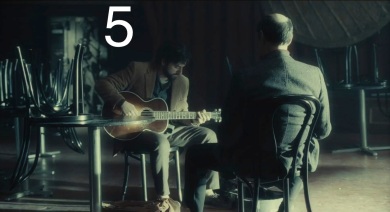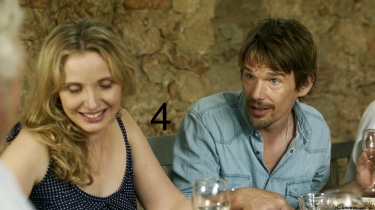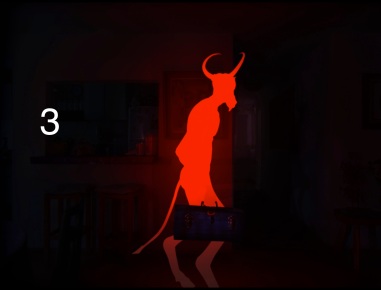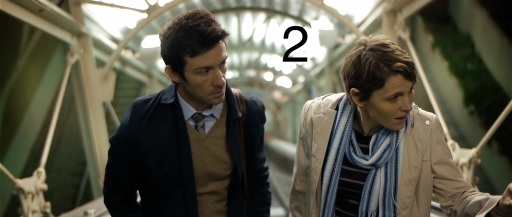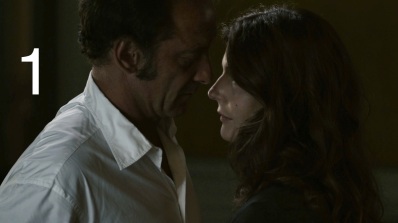Because “film” is often materially incorrect at this point and “movies” is insufficiently pretentious. Happy medium for my favorite medium.
Anywho:
Gravity
Many moviegoers I know are suspicious of beauty; they think they’re somehow being tricked by it. They require it to be yoked to something “real,” something to do with situation and character, as exemplified by Alfonso Cuarón’s adaptation of Children of Men. Ace cinematographer Emmanuel Lubezki’s dazzling long takes (he also shot the last three Terrence Malick flicks) trap the audience in a future stagnant in its own childless present, triangulating our position between that bleak environment and attractively damaged protagonist Theo, whose heightened subjectivity (awakened, Spielberg-style, by the need to protect a surrogate family) is what’s at stake in those set pieces. The director’s long-awaited follow-up instead strands its characters in pure Nothing, demanding they assert their Something-ness to escape.
Gravity‘s metaphysics are inherently caught up in its surface appeal, its sheer beauty reflecting the still-staggering marvel that is space flight. That anything exists up here at all, where the trailer informed us “life is impossible,” is a miracle, and so the survival narrative becomes less about “making it home” (where our hero has nobody waiting for her anyway) then about waking oneself up to the constantly unfolding revelation of Being.
As such, Cuarón and Lubezki perpetually stop their signature kinetic disaster-ballets dead, leaving us alone with Sandra Bullock floating in her spacesuit: centimeters from infinite death, with every passing second marking another moment she’s still living and breathing and thinking and feeling. The effect is less suspenseful than purely empathetic. As mentioned, Cuarón’s borrowing more than a few tricks from Spielberg here, chief among them his reverence for the expressive capabilities of the human face. Witness the shot in Children of Men when Theo’s bemused expression crumbles into anguish in the foreground while hearing the story of his son’s death related in the background, or the Truffaut-cribbed freeze frame of Harry Potter roaring with joy, all his loss and trauma momentarily forgotten in the delight of broom-flight, that brings Prisoner of Azkaban to a close.
It’s a rare and necessary emotional intelligence, matched by unashamedly virtuosic and formally audacious filmmaking. Gravity is Cuarón’s purest expression of techno-humanism to date because its very existence, moment to moment, speaks to the miracle of its creation: there is a face in space. Form is content. Medium is message. Gravity is beautiful.
The Act of Killing
It’s a literally killer hook: the paramilitary captains responsible for murdering over a million people in the horrific anti-Communist cleansing of mid-’60s Indonesia are asked to (bloodlessly) re-enact the killings on camera. They eagerly agree, every one. Not only are they utterly free of remorse, they’re thrilled at the chance to act like the silver screen killers they fell in love with when Hollywood first broke into the South Asian market, only a few years before the slaughter began.
In theory and execution (puns are how I cope with trauma, apparently), The Act of Killing addresses nearly every complaint made about the lucrative modern documentary industry: that it’s smug and self-righteous, picking on easy targets and offering pat solutions; that it’s aesthetically either dull or exploitative, or manages to somehow be both; that it pretends to truth without truthiness, and vice versa. By having the gangsters (a word which, in its social, political, and cinematic resonances, becomes the central object of discussion within the film) remember and, more crucially, re-imagine the killings, the filmmakers force them to take responsibility both for what happened and for the personal and collective memories left behind. But they quickly get over it: they have grandkids now, beer to drink, songs to sing, favorite movies to watch again and again. Indeed, former gangster Anwar Congo watches a scene from earlier in the movie and criticizes his own performance, the implication being that even this righteous, devastating, and utterly necessary film will immediately be absorbed back into the aesthetic overload of modern media.
This is how history is made, after all. Our subjectivity collides with the official record, both with very different claims on truth, and sometimes empathy must travel where facts cannot. The Act of Killing is a movie completed by its audience, with the actual murders only an idea seeded in our nightmares, which we must reconcile with the charming, charismatic sociopaths on screen. (I’m reminded of Louis CK’s objection to the phrase “the N-word,” forcing us as it does to say “nigger” in our heads so the speaker doesn’t have to.) Ghastly as it sounds, the narrative has the feel of a high school reunion: old friends getting together to reminisce about the glory days. They don’t care if we’re outraged, which should make us even angrier.
The Grandmaster
Wong Kar-Wai’s fractal romances, among the most widely and justly beloved movies of the last 25 years, focus on moments so obsessively that their characters’ lives are utterly ruined by nostalgia and regret: “One minute before 3pm on April the 16th, 1960” in Days of Being Wild, or “At the height of our intimacy, we were just .01 cm from each other” in Chungking Express. When the director instead goes wuxia, as with Ashes of Time and now The Grandmaster, genre norms dictate he observe characters more in tune with the present as they smack down legions of opponents. But what lingers in the characters’ visions (forming the basis for memories, Wong’s boats borne as ceaselessly back into the past as Fitzgerald’s) are raindrops dripping off the brim of one’s hat, not gore and glory. (Glore?)
Grandmaster eschews the standard kung fu training montages (its characters are already experts) to dwell instead on what masters do when they’ve achieved all they can, and how they cope when their country (inter-war China) is crumbling and changing all around them. Wong constructs a delicate episodic narrative around these ideas, and many complained it felt fragmented and oddly paced. But Grandmaster‘s true subjects are bigger (the ethics and aesthetics of combat, the modernization of tradition, the resulting fight over the role of women) and smaller (color, movement, space, and the universal melancholy of watching time slip past you) than the rise and fall of Ip Man, who seems oddly content to recede into the background of his own story (see also Inside Llewyn Davis, below). The fluid skill and dazzle of the set pieces (scroll down to watch the snow-bound duel between genre stalwarts Zhang Ziyi and Zhang Jin, both just barely avoiding being flattened by what must be the world’s longest train) is as rooted in environment as in character, the former most memorably represented by the Golden Pavilion, a filigreed arena/brothel where physical combat transforms without warning into philosophical debate and the lines between fighting, dancing, and fucking are perilously thin.
The next war approaches, people move in and out of your life, and The Matrix lied: kung fu does not make time stand still. But what it can do is focus our attention so intently on The Moment that familiar places and faces (and genres) become enchanted. What more do you want from movies?
A Touch of Sin
It seems like every American has an opinion on China, despite its beyond-corrupt government working so hard to repress accurate reporting of life beyond the shiny Olympics-era skyscrapers. Thankfully, there is still Jia Zhangke, furious chronicler of the dispossessed, a one-man anti-censorship army fighting for a truly international cinema devoted to shining (literal) light on ignored places and peoples, maybe the finest artist-activist of his generation…and you don’t need to know any of that to be floored by his fables of quiet desperation among the dislocated industrial workers of northern China, not to mention dazzled by his restless aesthetic range, using both 35mm and digital video to shoot fiction-documentary hybrids in search of truth/Truth.
A Touch of Sin finds him in full operatic mode, stitching together four disparate stories of personally (not just politically) sympathetic migrants driven to violent breaking points. Jia has largely abandoned the sober social realism of his early work, adopting a more epic and modern feel to emphasize the existential malaise plaguing his characters; they lash out not only out of economic desperation, but seemingly in reaction to something in the air, the land, the water. Something is rotten in the state of China, and traditional journalism has proved utterly inadequate at exposing what that is. And what is it? Maybe not even violence, but its repression, the pathetic eagerness to show a content face to the foreign investors that still dominate every sector of what will soon be the world’s largest economy.
Violence, displayed directly, is still taboo in most Chinese art, and its blunt force and presence in A Touch of Sin has attracted a storm of controversy even by Jia’s standards. But the director’s aim may be most clearly expressed in the title, a nod to the King Hu wuxia classic A Touch of Zen. Jia references Chinese film history even as he’s writing its future, a tribute to a people left behind in a nation increasingly defined by outsiders in terms of what it may become. Present-day China is indeed a powder keg, but one faced inward; it has several more revolutions to go before conquering the rest of the world, and until and unless the government locks him up like Iran did to his fellow radical filmmaker Jafar Panahi, Jia Zhangke will be there to capture it all.
To the Wonder
Terrence Malick’s previous three films after returning from twenty years of self-imposed exile were about Big Things: World War II (The Thin Red Line), American colonialism (The New World), and the origins of time and space (The Tree of Life). As such, his choice to shoot the opening images of his latest on an iPhone, the newest and smallest of Big Things, should’ve been enough to silence the critics who called the movie a retread. To the Wonder is the Malick Movie boiled down to its most intimate, human-scaled essence: a constantly roving camera working to throw the beauty of human transience into sharp relief against the eternal recurrence of the natural world, only to be so excitably distracted that it can’t help interrupting itself with a new image, a new time and place and person, a new wonder.
The resulting time-lapse is (as always) viscerally overwhelming, but Malick’s previous work had been shot through with the semi-objective perspective of a benevolent observer (Malick himself? Or Nature Itself?) keeping track of the unfolding big picture in terms of its own unique priorities. To the Wonder, abandoning epic historiography in favor of an intensely private story of restless love, lingering regret, and the emotional navigation of religious faith, feels more like paging through someone else’s diary guiltily discovered in a new home’s attic. It has that uncanny excitement of the familiar world made alien by a stranger’s perspective, perfectly suiting a film about geographic and spiritual dislocation yet, paradoxically, firmly rooted in time and place. For the first time, Malick incorporates non-actor locals (from the Oklahoma towns of Bartlesville and Pawhuska) into his usual ad hoc community of drifters and wanderers; also for the first time, he addresses a specific religion (evangelical Christianity) instead of a purposefully vague spirituality.
This may all be in pursuit of a truer Truth, or simply a more unvarnished poetry, for what lingers about Javier Bardem’s Father Quintana are not the sermons he delivers but the tired, drawn, doubting, and occasionally ecstatic face he wears while doing so. Malick reaches for the heavens and into the distant past for inspiration, but like his peer Spielberg (and the two have more in common than their reputations would suggest), his stories always bring us back down to the ordinary, to regretful people trying desperately hard to live in the moment, and always failing. But, y’know, beautifully so.
Inside Llewyn Davis
Given how thoroughly American pop culture embraced them in the Pulp Fiction era, it’s remarkable that we may look back at this last decade as the time in which Joel and Ethan Coen really got good. Recovering from their mid-aughts descent into miserably unfunny comedies, the brothers roared back with a trio of superbly unsettling, intricately constructed infernos (No Country for Old Men, Burn After Reading, A Serious Man) housing their most befuddled and strangely tragic puppet-characters to date, thereby earning a gorgeously shot bit of coasting in True Grit.
That last film’s surprising simplicity (not entirely successful, but building to a indescribably moving epilogue) is refracted here into a hushed emotional minimalism, a pointed refusal to engage with the histrionic cliches of the early ’60s Greenwich Village folk explosion, alighting instead on a story both deeply sad and thoroughly at peace. The Coens have nothing left to prove, so naturally Inside Llewyn Davis is about an artist with everything to prove, but stuck (wait for it) inside himself.
I love passive protagonists (ahem, Eyes Wide Shut), partially because they make ideal audience surrogates, but also because they emphasize one of the Coens’ defining themes: story, like life, is something that happens to you, with your own free will serving as a marginal influence at best (if it even exists at all, which the aforementioned Hellfire Trilogy very much doubts). Llewyn watches as the Boomer mythos unfolds and moves past him, content to be his own audience, never popular enough even to be exploited. John Goodman, proving yet again no one can play grotesque quite like he can, drags Llewyn along on an oh-so-allegorical road trip with promises of fame, but the managers “don’t see a lot of money here,” something the Coens themselves have surely heard over and over.
There will always be a Bob Dylan (who haunts every frame) forced to make peace with that corruption, and there will always be an Andy Warhol to turn that commercialism back into art, but there’s always a hundred Llewyns behind them, their stories quickly ironed out in favor of the pat, self-fulfilling myths the brother directors have spent their mutual career deconstructing, filling in the corners with indelible details. For example, Inside Llewyn Davis features a cat, who goes by (what else?) Ulysses. He might actually be the main character.
Before Midnight
It’s official: the Before triptych is the greatest movie series ever made. Before Sunrise was such a golden gem, all flushed young romance and splendorous old Vienna, so in love with movement (opening and ending with images of train travel) that of course Before Sunset had to drag Jesse and Celine to a halt, forcing them to review the nine normal years they spent apart in light of that one magical evening. But Before Sunrise also deals forthrightly with loss, the fallibility of memory, and death–remember the cemetery scene? Likewise, Before Sunset finds plenty of time for crisp flirtation and Parisian beauty (of the human and architectural varieties) even as the semi-real-time clock counts down to devastation.
There’s no actual contradiction there, as we all walk around with such divergent emotions and themes clashing in our heads and hearts; one critic, defending the sorely undervalued School of Rock, captures perfectly director Richard Linklater’s “conceiving of individuals as containers for diametrically opposed forces.” Before Midnight finally brings this story where it was always going: a half-psychological, half-geographic plane where joy and sorrow, past and present, are constructs to be used as weapons (and shields) by two ferociously intelligent, preposterously charismatic, and apparently eternally beautiful people.
It was the change in those faces that made visible the time passed between Sunrise and Sunset; now it’s the change in the landscape that reflects the damage done. If artfully tumbled Greek ruins have replaced vibrant cityscapes, have Our Heroes reached the end of their love as well? (Oh, setting. You metaphor, you.) But they’ve come to show the ruins to their children, adorable blond twins, before they head off to a gorgeous villa for a delicious meal full of sparkling conversation with fascinating people, each of whom could easily have carried their own movie.
Of course, Jesse and Celine are too stubbornly honest for unexamined bliss, and while spending the night at a (suitably allegorical) peninsular hotel, they uncover cataclysmic veins of resentment, arrogance, and despair. But they’re too fascinated by their own story to ever let it stop, mutual narcissism being one of the more undervalued wellsprings of love. They’re finally in control of their life together, and while they miss their youthful spontaneity more than they seem to realize, Linklater and his actors (all three co-writers) can recreate it like magic.
Post Tenebras Lux
If you’ve heard tell of this one, the latest sorta-provocation from Mexican enfant terrible Carlos Reygadas, you’ve probably heard it’s…esoteric, to put it politely. But look at the shot above! It’s a charmingly simple animation of the Devil, wandering a house while the increasingly troubled family sleeps. That sounds like an obvious enough metaphor when I spell it out like that, so what’s all the fuss?
Later on, we see a chess game laden with stoner shit-talking; a nervous trip to a bathhouse sex club transformed into a cleansing existential reverie; a married couple, one sick and one sad, singing Neil Young’s “It’s a Dream,” thereby outing the picaresque haze in which this all unfolds. This is, indeed, a collective dream, Family, Society, and even Nature in flux. If there is a definitive sequence in Post Tenebras Lux, it’s the first one, embedded below: an adorably overexcited little girl (the director’s own daughter) wandering a lush valley, chasing unperturbed cows and dogs, only to suddenly notice that it’s gotten dark, a storm is coming, and she is alone.
So much of the movie seems told from the perspective of a gradually maturing child, equal parts visceral delight, baffled incomprehension, and that subtle melancholy that marks the birth of a broader perspective. Reygadas, as per usual (see especially Battle in Heaven) lends his talent to collapsing all these angles into a single frame. Near the story’s end, two children are approached by a family friend concerned about their aforementioned ailing father. They reply cheerfully, “Come play with us, cause Dad has died already.” The camera holds, allowing both character and audience to absorb the shock, but the kids keep playing, and the verdant hills behind them are no less beautiful for the loss they now contain.
It’s a messy, deranged, ludicrously ambitious film (the title is a Latin phrase meaning “light after darkness,” for fuck’s sake), so it’s necessarily humbling that its most distinctive aesthetic signature (and most revealing visual metaphor) was a mistake. Reygadas accidentally doubled the image around the edges of the frame in post-production, but liked the resulting impressionistic blur so much he left it in. It’s appropriately spontaneous for a movie that feels like it can go anywhere, do anything, and does: a hint of magic at the corners of your sight.
Upstream Color
The problem (or one of them, anyway) with summarizing aesthetically/intellectually/emotionally complex cinema is the elision of how it actually feels to watch such a work unfold in time. Analysis too often presents itself as one fully formed lump, when it is always actually formed through gradual accumulation as the minutes tick past and the eyes and mind wander.
So to interpret Upstream Color in terms of how I felt when it was over (I was crying, for the record) is to ignore everything that led me to that point: the dazzling images flitting past at a Malickian speed yet locked together in precise Kubrickian fashion, the staggering extremes of its meticulous sound, the delicate play of light and shadow, and the deadened faces of characters far too crippled by trauma and self-doubt to notice any of that beauty. Emotion moves faster than narrative, time and space are established and then abandoned, texture is all even when repellent.
This may sound arthouse-y beyond redemption, but director/writer/scorer/editor/cinematographer/actor Shane Carruth (self-taught, naturally, and more talented than every other Sundance winner combined) knows the first rule of experimental narrative: immerse your audience in the emotional fabric of your characters’ crises, however obtuse those may be. His debut Primer was a cult smash and remains one of the most singular and impressive movies of the ’00s because its mesmerizing Mobïus strip of a time-travel narrative is firmly rooted in the repressed ambitions of his characters and the everyday, disconcertingly recognizable world they inhabit. When the clearly lifelong friendship at the core of that movie finally collapsed under the weight of betrayal, the devastation cut through the intricately nested plot; the hurt and loss were painfully intimate, even if you had long lost track of how many doppelgangers there were and where and when.
Upstream Color turns its clouded gaze on romance instead, but both movies use sci-fi detritus to diagnose the dissolution of the individual, lost in a lifestream of images and restored only by the edits between them. When they finally find catharsis, we do as well, even if we never fully understand the terms by which that (no doubt temporary) peace has been secured. Sounds like life, love, and moviemaking (and, inevitably, Eyes Wide Shut) to me.
Bastards
Claire Denis (like the aforementioned Carruth and Reygadas, both of them professed fans and clear aesthetic disciples of hers) has largely earned her reputation for narrative impenetrability. The fluid, tactile camerawork, seductively caressing bodies in motion, is there to lure you in, giving you some time to work out what exactly is happening and how to feel about it. But she always leaves breadcrumbs behind, and the title of her latest banishes subtlety from the frame. Bastards. The anger and sorrow humming beneath her best works was finally given full, terrifying form in the anti-colonial jeremiad White Material (my fave flick of 2010), and is now rotting in every frame of this fractured noir.
It plays as a impressionistic riff on Chinatown, with its cynical sleuth devastatingly unable to prevent a rapacious patriarch from torturing women and killing any beta male that gets in his way. But where Polanski digs deep into social/political context, emphasized in his static, painterly tableaux, Denis drops us into an alien yet bizarrely intimate world and leaves us to figure out the rules, the prowling camera pushing up almost too close to the actors, as if trying to get under their skin to better diagnose the decay within. Form meets content: our dislocation is mirrored in protagonist Marco’s, returning home from years at sea (noir heroes seek refuge in Nothingness, bringing us back around to Gravity) when his sister pleads with him to save her daughter from the monstrous Edoaurd.
The latter is played with perfect skin-crawling sleaze by the great Michel Subor, who seems to haunt the director’s nightmares; from the (almost literally) heartless ex-mercenary in L’Intrus to the bloated plantation owner in White Material, Subor’s constant presence in Denis’ work emphasizes this archetype’s persistence across time, space, and genre. Marco, sadly, is not the knight to slay this dragon–he’s the director’s Hamlet, a morally outraged man who sets out to deliver justice, but instead slowly collapses inward, finding inside himself not righteousness but a terrifying void. He first sleeps with Edoaurd’s mistress (the peerless Chiara Mastroianni) after hearing the hideous details of his niece’s suffering. Is he trying to banish the trauma of sexual abuse via his own sexual catharsis? Or exploit another trapped woman to somehow punish Edoaurd? Or (worst of all) is he actually turned on by what he has seen and heard? Denis refuses to spoon-feed us his motivations, so they’re all left swirling together, each potentially present in each shot.
This, to bring the list to a close, is what cinema can do that no other art form can. As always, I return to Eyes Wide Shut, specifically Michael Koresky’s encapsulation of that film’s sinuous effect: “[I]t snakes its way into your subconscious and lies there in wait.” Moving images exist in time; they die. They flash on the screen, indelible in their force and presence, and then are gone; this is why movies are so often compared to memories and dreams. Film dissolves theory into ether, lending it a diffuse, visceral presence, which is why so many will always consider it subservient to literature, theater, reality. They are as wrong as it is possible to be. Perhaps the medium’s definitive trait is its uncanny ability to hide its author, but no one with even a passing interest in making better movies should ignore Claire Denis. She’s the finest working filmmaker, her oeuvre the apex of cinema’s second century so far, a gleaming hint of what movies could be by 2030, 2050, 2200. I can’t wait.
